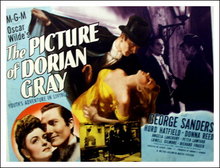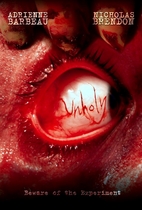Our editor-in-chief Nate Yapp is proud to have contributed to the new book Hidden Horror: A Celebration of 101 Underrated and Overlooked Fright Flicks, edited by Aaron Christensen. Another contributors include Anthony Timpone, B.J. Colangelo, Dave Alexander, Classic-Horror.com's own Robert C. Ring and John W. Bowen. Pick up a copy today from Amazon.com!
The Picture of Dorian Gray (1945)
The Picture of Dorian Gray, Albert Lewin's 1945 adaptation of Oscar Wilde's classic novel is both an entertaining and frustrating film. It is very well made, with stylish direction, wonderful performances from much of the cast, and it tackles some serious and thought provoking themes. Unfortunately, it takes its topic too seriously, and its main character appears throughout as not much more than a cipher. Boredom also has a tendency to set in at times, a fatal flaw for a horror (or any other genre) film. While worth watching, The Picture of Dorian Gray never reaches greatness.
The story opens in late 19th Century England, with the introduction of the amoral Lord Henry Wotton (George Sanders), a glib dandy who claims that he lives only for pleasure. At the home of the painter Basil Hallwood (Lowell Gilmore), Lord Henry meets the young, handsome and impressionable Dorian Gray (Hurd Hatfield), just as Basil is completing a portrait of Dorian. Lord Henry mentions that as Dorian grows older, he will lose his youth and attractiveness. Dorian mournfully wishes aloud that he would stay young and that the picture would grow older instead. He doesn't realize that his wish has been granted, and that he has irrevocably changed his life forever. He adopts Lord Henry's theories about living for pleasure, and despite many terrible deeds, he still looks as young and innocent for twenty years as he did on that fateful day. His picture, however, slowly changes into one of a hideous monster. Even as Dorian causes the suicide of his fiancée Sybil Vane (Angela Lansbury) and murders Basil, no one in England suspects the terrible bargain that Dorian has made.
Lewin, who wrote the script as well as directed the film, provides a faithful adaptation of Wilde's novel. While he does alter a few events and includes a mysterious statue of a cat that grants Dorian's wish to remain young, the story and characters are largely the same. Lewin realizes that Wilde has some serious concerns to address; he does not try to change the story in order to make it more like the many other horror films of the time. He lets the story unfold much as it did in the novel, and we are therefore presented with a more adult story than many of the other screen terrors of the day.
One of the advantages of Lewin staying close to the novel is that the pithy wit and keen insights of Wilde are thankfully preserved. Many of the amusing epigrams of the novel, chiefly voiced by Lord Henry, are preserved, often completely intact. Lewin's literate script does not oversimplify the novel's ideas for the screen, either. We easily see the Freudian group of characters that Wilde created (Basil represents Freud's super-ego, Lord Henry represents id, and Dorian represents ego), and an attentive viewer will be drawn in by the complex philosophical questions that Wilde was asking.
Unfortunately, this strong adherence to Wilde's literary source also compromises The Picture of Dorian Gray as a film. One example of this is the narrator (an un-credited Cedric Hardwicke), who at times seems as if he is reading long passages straight out of the novel. Sometimes this is necessary (particularly given the bland performance of Hatfield, which will be discussed below) to let us know some of the more complicated thoughts of Dorian, and it also allows us to hear samples of Wilde's amusing prose (such as the line that begins the film which says that Lord Henry had perfected "the aristocratic art of doing absolutely nothing"). However, this approach does not give the viewer any credit for being able to figure the story out on their own, which can be particularly annoying. It would have been as if we were watching Karloff's creature stagger out of the Hermit's burning building in Bride of Frankenstein, and we heard Elsa Lanchester's voice saying, "The Monster was terribly saddened by the loss of his only friend." The film's story is not so complex that we need someone to walk us through it as we watch, so the constant narration is a detriment to the film.
The narration is just part of the major problem with Lewin's film: when it comes to Dorian's amoral actions, it would rather describe them than show them to us. Throughout the film, the narrator keeps on telling us that Dorian is involved in such depraved things that people are afraid to even be in the same room with him. However, none of these things are ever shown or even described. It is of course not necessary to show everything bad in a horror film. In fact, keeping the most violent or grisly events away from the viewer can make us imagine things worse than any filmmaker could show. This film, however, take this idea too far. Except for Dorian's initial cruelty to Sybil, and his later blackmailing of a former friend, we have no on-screen examples of Dorian doing anything bad. All we do see is a young man-about-town going to series of dinner parties and skeet shoots. His one violent act, the murder of Basil Hallwood, is stylishly done, but the film needs much more of these types of scenes to really make us feel that Dorian is a despicable person in a handsome cover. An effort to preserve the essence of Oscar Wilde's style results unfortunately displays rather in laziness on Lewin's part. It is not very easy to be shocked at an unnamed voice saying that a character is doing bad things without even hinting what those are.
It is fortunate that Lewin's direction is both stylish and effective. Whenever we are in Dorian's house, Lewin is careful to keep the cat that granted Dorian's wish in view as a reminder of the pact that Dorian made. Mirrors are almost always present, emphasizing both Dorian's narcissism and also the duality of humanity. In many scenes, the camera points upwards at the room in which Dorian has hidden the picture, reminding us that it has become the most important thing in Dorian's life. Lewin's most striking decision, given that this is a black and white film, is to sometimes show Dorian's portrait in full color. Obvious as this technique is, it is nevertheless shocking and does show us that the portrait is both Dorian's dream come true and his conscience.
The cast of the film has two outstanding performances and one unfortunately bland one. George Sanders is perfect as Lord Henry. He brilliantly portrays Lord Henry's cynicism and amorality, casually making assumptions both humorous and incisive, all with a self-confident voice and amused smirk. He is able to tempt Dorian to sell his soul for youth and to treat his loving fiancée cruelly, all with the tone of someone recommending a good restaurant. Angela Lansbury received an Academy Award nomination for her performance as the naive Sybil Vane. She plays her character with a tender sweetness that is cruelly crushed by Dorian. She is especially good in the scene when Dorian tries to tempt her to spend the night with him. With only a small frown and a single tear, Lansbury shows us how completely the happiness Sybil thought she had found has been shattered. Lansbury is not in the film long, but she makes a lasting impression on the viewer.
Of all of the main characters, Hurd Hatfield gives the most disappointing performance as Dorian. He is handsome in a bland way, but he plays his character so emotionless and so woodenly that it is difficult to believe that he is going through any inner turmoil at all. He recites his lines as if reading from cue cards, and speaks in a low, quiet voice that may have been intended to sound menacing, but instead is just dull. His lackluster performance is a severe problem, as he never makes us care about his character.
All in all, The Picture of Dorian Gray is a good but not great film. Its direction is handsome and skillful, and most of the performances are excellent. Nevertheless, the film does not trust the audience to figure out its themes, and the main character is played more like a male model than a wicked person. The film is recommended, but do not expect a horror film on the level of Dr. Jekyll and Mr. Hyde or The Bride of Frankenstein.
This review is part of our Shocktober Classics 2009: Staff Screams event.









The movie is fine. I ' m
The movie is fine. I ' m using for my English language teaching.
I like it, I saw it for my
I like it, I saw it for my ENGL class...